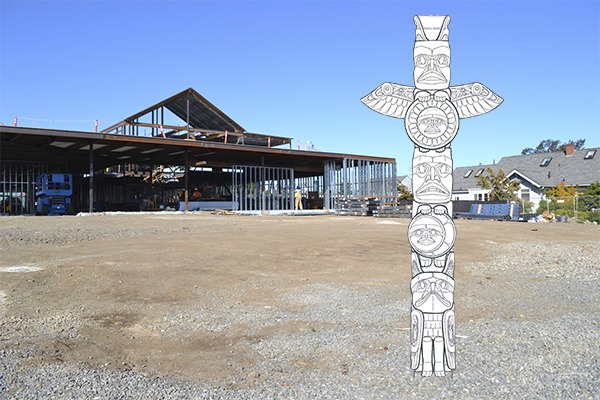Dale Faulstich, lead carver and designer for the Jamestown S’Klallam Tribe, is readying a totem pole to reveal why the sun always shines in Sequim.
He and a small team plan to create a 30-foot totem pole, valued at $150,000 for the City of Sequim’s Civic Center set to be placed in the plaza next to Sequim Avenue.
The Jamestown S’Klallam Tribe is donating the totem pole that depicts a story adapted by Faulstich as told by Robbie Davis called “Why the Sun Always Shines in Sequim” from the book “Klallam Folk Tales” by Erna Gunther.
Faulstich and his team Bud Turner, Dusty Humphries and Tyler Faulstich, his son, will begin shaping the Western red cedar log from the Hoh River valley next week.
“I think it’ll be fun to do something for the city,” Faulstich said. “It’s nice lumber. We’re excited to get into it.”
The city last partnered with the tribe to decorate an electrical box with a vinyl wrap designed by Faulstich on the northeast corner of Sequim Avenue and Washington Street.
W. Ron Allen, chairman of the tribe, said they have a long history with the city and are proud to make the commitment to commemorate the partnership.
“The city represents a diverse set of cultures and interests and the totem pole will recognize and honor the American Indian relations,” he said.
Sequim Mayor Candace Pratt said city officials are excited about the donation, too.
“(We) feel it is the perfect symbol of the cooperative relationship that the city has long enjoyed with the tribe,” Pratt said.
The $16 million new Civic Center that includes the city hall and police station is under construction through mid-2015.
Public Works Director Paul Haines said Lydig Construction is in the early stages of designing the plaza and where the totem pole will go.
A sunshine story
Prior to adding this new totem pole to the fold, Faulstich guesses he has created at least 35 totem poles on the Olympic Peninsula.
Right now, his team is finishing up a 37-foot totem pole for a tribal casino in New Brunswick, Canada, and refurbishing two totem poles for the front of the 7 Cedars Casino in Blyn.
He designed the city’s totem pole several months ago but said it’s likely going to change somewhat.
“I plan to fine tune it this week,” Faulstich said. “Now that we have the log selected I’ll draw it to the exact proportions of the log. I’d rather make my mistakes on paper than on the log.”
With the traditional S’Klallam folk tale, Faulstich said he’s adapted it to make his own.
“I tell my stories in wood rather than verbally,” he said.
The abbreviated version of “Why the Sun Always Shines in Sequim” goes something like this.
A long time ago, it was always cold and wet on Earth because the “Chief of the Land Above” kept all the heat and light trapped in his home in the “Land Above.” Meanwhile, a small village called Scqwe’yen or Skwim or Sequim, was struggling to survive, including a a man and his wife and their two sons Kweye’cen and Sck’ayec.
The man prayed for pity from the Chief Above and paddled to the bay but the Chief Above sent the Northwind to capsize his canoe and the man died.
Over the years, the young men became competent hunters and fisherman and eventually healers and learned to help their village.
Eventually, they felt duty-bound to avenge their father’s death and both shot arrows into the sky until they attached to become a long rope leading to the Land Above.
There they came across Skwesqq (Robin) and Kwiskws (Blue Jay) who were blind, so using their healing abilities to find medicinal plants, the brothers healed the women. In a discussion they learned the Chief Above was the sisters’ father who blinded them with bright lights. Robin’s chest and Blue Jay’s hair and head are burned from his fire pit, too.
The sisters and brothers agreed to work together and with each others’ help, the brothers swiftly killed the chief. The brothers stayed in the land above and married the sisters but wanted to help their village.
So the elder brother offered to carry the large ball of light across the sky every day and call himself Sqwqway (the Sun) while the younger brother offered to carry the moon or Ceqtlqayc while keeping watch over the village of Scqwe?yen (Sequim).



